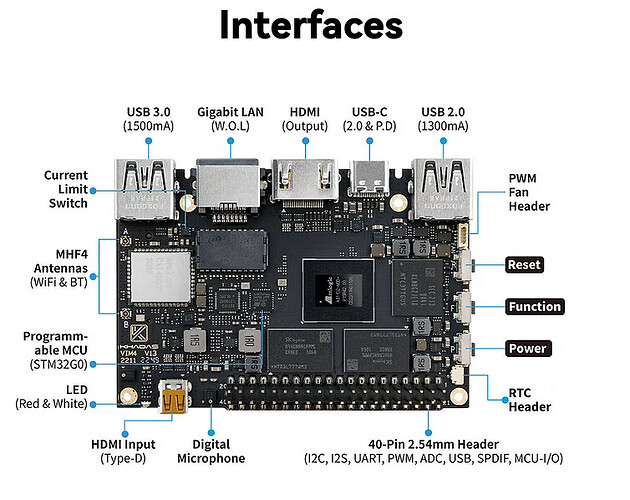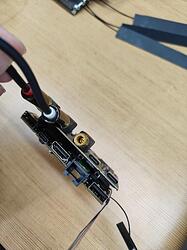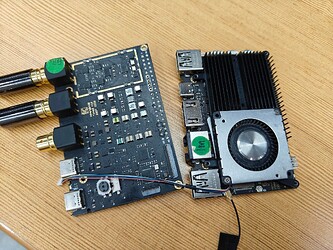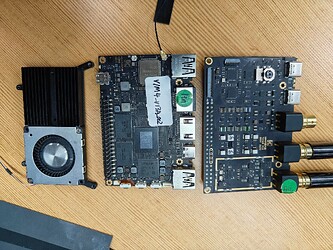Thank you!
One more question regarding this screen topic:
I found a few options which supposed to work after Android 11+:
Open a root shell on your phone, then run:
wm size # to get your current phone display size
wm size 1080x1800 # slightly reduce the display size
Do we have a root shell by default? Can I expect these command working?
Maybe we can also use wm overscan? It supposed to work with Android 11.
@danergo ,
Yes, we have support. This is a good idea.
1 Like
In order to plan the product I reviewed my initial requirements regarding the connections.
Some items are still missing, giving some extra questions.
Let’s start with connectivity: 5G / LTE & GPS:
1.) Is “Quectel EM06 4G LTE” (link) usable in your Android build for both LTE and GPS?
2.) Do I need your “New M2X Extension” (link) board for adding this Quectel LTE Module to VIM4?
3.) For “Backup camera” I believe I have the same problem as with the display: camera will be extremely far (4m) from the board. Seems straightforward: shall I use HDMI in for the camera? Is it supported in your Android build?
4.) I saw there is a nice aluminium case for the VIM4 (link). Can I fit VIM4 with active cooling kit and new M2X Extension board (with Quectec module) into this aluminium case?
5.) For audio output I need either basic stereo output or SPDIF/TOSLink. Which one is supported by default with your Android?
6.) Microphone input (for speakerphone). I saw there is a “Stereo Digital Microphones” on the datasheet. I need an external microphone to be connected to VIM4. Which interface would you recommend for this? (Again which is supported in Android)
7.) I believe I’ll have to find a good FM Tuner into USB. By any chance do you have anything which you would recommend? I found some with RTL2832 chips. Is your kernel supporting it?
Thank you very much!
@danergo ,
Q:Is “Quectel EM06 4G LTE” (link) usable in your Android build for both LTE and GPS?
A:Yes
Q: Do I need your “New M2X Extension” (link) board for adding this Quectel LTE Module to VIM4?
A:Yes
Q:For “Backup camera” I believe I have the same problem as with the display: camera will be extremely far (4m) from the board. Seems straightforward: shall I use HDMI in for the camera? Is it supported in your Android build?
A:Yes
Q:I saw there is a nice aluminium case for the VIM4 (link). Can I fit VIM4 with active cooling kit and new M2X Extension board (with Quectec module) into this aluminium case?
A:Only cooling kit
Q:For audio output I need either basic stereo output or SPDIF/TOSLink. Which one is supported by default with your Android?
A:SPDIF
Q:Microphone input (for speakerphone). I saw there is a “Stereo Digital Microphones” on the datasheet. I need an external microphone to be connected to VIM4. Which interface would you recommend for this? (Again which is supported in Android)
A:USB Microphone
Q:I believe I’ll have to find a good FM Tuner into USB. By any chance do you have anything which you would recommend? I found some with RTL2832 chips. Is your kernel supporting it?
A:The kernel has driver code, but we have not verified it.
Perfect, I really appreciate your comments!
SPDIF is only available on 40pin header, correct?
It seems I’m started filling up the board’s connection correctly 
Can you tell me what’s the purpose of the “Digital Microphone” (next to 40pin header)?
Thank you!
@danergo ,
Q:SPDIF is only available on 40pin header, correct?
A:Yes
Q:Can you tell me what’s the purpose of the “Digital Microphone” (next to 40pin header)?
A:Used in recording scenarios where sound quality requirements are not as high.
1 Like
Thank you very much! For now, all questions have been cleared.
Will post here my further results and followup questions.
1 Like
Hi @william.lin:
I have a question with the SPDIF implementation.
I’m looking now on the Tone1 (and Tone2) addition boards. They seem providing me a very nice audio response.
They are sitting on top of the 40pin header.
Q1. Can you confirm they are using the SPDIF or something else for outputting audio?
Q2. Are their board supported in your Android build?
Q3. Can I install their board and still add the heatsink with the fan?
Thank you very much!
Also, please confirm:
Will this module work with Android?
“Quectel RM520N-GL”
I wish to add 5G/LTE connectivity and this seems more future-proof, than LTE-only “Quectel EM06”.
@danergo ,
Q:Will this module work with Android? “Quectel RM520N-GL”
A:The Android 11 system is already supported, and the Android 14 system will soon release a supported version.
1 Like
@danergo ,
Q1. Can you confirm they are using the SPDIF or something else for outputting audio?
A: YES
Q2. Are their board supported in your Android build?
A:YES
Q3. Can I install their board and still add the heatsink with the fan?
A:YES
1 Like
Hi!
I have some valuable followup-questions:
Q1. After connecting Tone1 (or Tone2) board, can I attach few more peripheral connections on the GPIO, or Tone board is taking all the space? (i.e. I wish to attach my wires to UART).
Q2. In Android build is Bluetooth Audio Sink profile enabled? This is crucial for CarBox (i.e to attach your phone to the car for handsfree). This topic gives a bit of information although it’s very old: https://stackoverflow.com/questions/27763756/android-device-as-a-receiver-for-a2dp-profile
PS: Is it okay for you if I post these followup questions in this topic, or shall I create a new topic for every new question? (For me it seems better having everything in one place).
Thx!
On this image, there is a "Programmable MCU (STM32G0).
Can I use this MCU to completely teardown (poweroff) Android (which I assume running on the main CPU)?
If yes, can I use this MCU to do low-level tasks (like various CAN-bus protocol parsing, etc)?
If yes, how much is the power consumption when the main CPU is powered off?
These are theoretical questions, as I originally planned to use another board for controlling the lowlevel tasks, but just found out about this MCU.
Q:Can I use this MCU to completely teardown (poweroff) Android (which I assume running on the main CPU)?
A:Sure, but we don’t open the source code of the MCU.
Q:If yes, how much is the power consumption when the main CPU is powered off?
A:Shutdown current:6.27MA
Q:After connecting Tone1 (or Tone2) board, can I attach few more peripheral connections on the GPIO, or Tone board is taking all the space? (i.e. I wish to attach my wires to UART).
A:Yes
Q. In Android build is Bluetooth Audio Sink profile enabled?
A: No
Thank you!
By “Connecting a Tone(1 or 2) board” I mean to “stack” the Tone board onto the VIM4. In this case, can I fit the heatsink?
I have to stick the Tone to the GPIO header, as the M.2 slot will be used by the 5G modem. And (correct me if I’m wrong) one m.2 slot can only host one peripheral at a time.
So let me rephrase this question: can I stack the Tone Board (Makers Kit) onto the VIM4 GPIO and still use the original heatsink and fan?
So MCU is only used for internal tasks? Without modifying it, can we add extra functionality? I.e it would mean you don’t open the source but provide some space for the users in the mcu to do basic low-level tasks (reading sensors, buttons, leds, etc).
I have read somewhere in this forum that Bluetooth Sink profile can be enabled from settings. I couldn’t find it now.
But: (How) is it possible to enable A2DP Sink Profile in your Android? Do I have to recompile it?
(Note: I do not need A2DP source profile, only sink: I wish to stream music to VIM4)
Appreciate your comments!
Q:By “Connecting a Tone(1 or 2) board” I mean to “stack” the Tone board onto the VIM4. In this case, can I fit the heatsink?
A:YES
Q:I have to stick the Tone to the GPIO header, as the M.2 slot will be used by the 5G modem. And (correct me if I’m wrong) one m.2 slot can only host one peripheral at a time.
A:YES
Q:But: (How) is it possible to enable A2DP Sink Profile in your Android? Do I have to recompile it?
A:YES
1 Like
Thank you very much!
In case I recompile Android without any modification, would I get the same build as the one presented in oowow launcher to install?
Just asking this for curiosity about performance.
Q: In case I recompile Android without any modification, would I get the same build as the one presented in oowow launcher to install?
A:YES
1 Like



